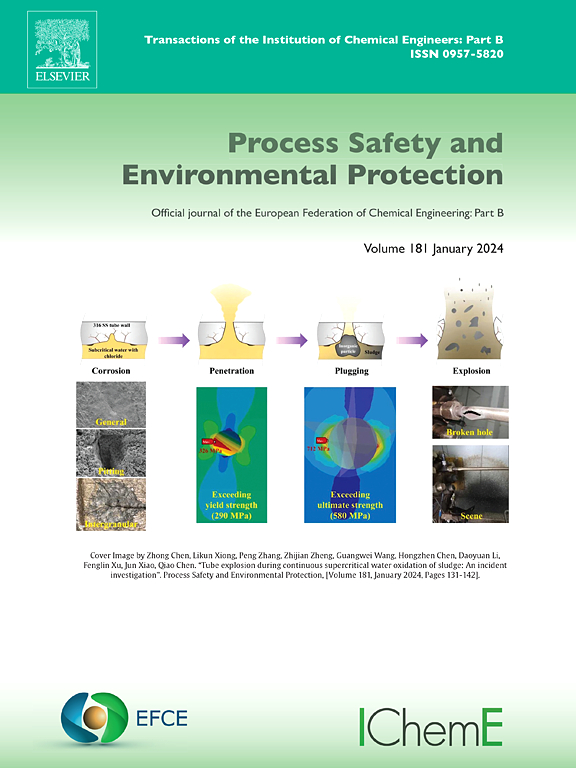碳纤维复合材料的熔盐热处理:结构对热固性树脂降解机理的影响
IF 6.9
2区 环境科学与生态学
Q1 ENGINEERING, CHEMICAL
引用次数: 0
摘要
从热固性复合材料中回收碳纤维具有挑战性,因为交联树脂稳定,传热性能差。先前的研究介绍了一种熔盐热处理方法,以增强热传递和反应性,用于回收清洁和高强度纤维。然而,不同的树脂对纤维的转化性能有显著影响,影响了纤维的回收率和树脂的利用率。研究了富酚树脂(EP)、富酯树脂(PA)和共混树脂(VE)等不同结构的扩展。热解实现了纤维分离,残余树脂<; 5 %,所有树脂强度损失<; 1 %。尽管结构不同,但树脂产生的自由基(氢和甲烷)相似,但液体油的组成不同。VE和PA生成芳烃,EP生成氮化合物和酚类。具体来说,熔盐显著破坏了交联结构,这可以从胺固化EP树脂的NH3排放量增加中得到证明。对于富酯树脂,熔盐的强碱性有效地促进了脱羧,释放出芳香烃。对于富酚树脂,在400 °C解聚释放酚羟基,与熔盐反应形成酚酸钠。随后温度升高到450-500 °C引起缩聚,产生炭沉淀。这些发现有利于纤维的回收和树脂副产物的利用。本文章由计算机程序翻译,如有差异,请以英文原文为准。
Molten salt thermal treatment for carbon fiber composites recovery: Structural effects on thermosetting resin degradation mechanism
Recovering carbon fibers from thermosetting composites is challenging due to stable cross-linked resins and poor heat transfer. Previous research introduced a molten salt thermal treatment method to enhance heat transfer and reactivity for recycling clean and high-strength fibers. However, the diverse resins significantly influence conversion properties, affecting fiber recovery and resin utilization. Expanding on this resins with varying structures were studied, being phenol-rich (EP), ester-rich (PA), and blended (VE). Pyrolysis achieved fiber separation with < 5 % residual resin and < 1 % strength loss for all resins. Despite structural differences, the resins showed similar radical production (hydrogen and methane), but liquid oil compositions varied. VE and PA yielded aromatic hydrocarbons, while EP produced nitrogen compounds and phenols. Specifically, molten salt significantly disrupted the cross-linked structures, as evidenced by increasing NH3 emissions from amine-cured EP resin. For ester-rich resins, the strong alkalinity of the molten salt effectively promoted decarboxylation, liberating aromatic hydrocarbons. For phenol-rich resin, depolymerization at 400 °C liberated phenolic hydroxyl groups that reacted with the molten salt to form sodium phenolate. Subsequent temperature elevation to 450–500 °C induced polycondensation, yielding char precipitation. These findings facilitate fiber recovery and resin byproduct utilization.
求助全文
通过发布文献求助,成功后即可免费获取论文全文。
去求助
来源期刊

Process Safety and Environmental Protection
环境科学-工程:化工
CiteScore
11.40
自引率
15.40%
发文量
929
审稿时长
8.0 months
期刊介绍:
The Process Safety and Environmental Protection (PSEP) journal is a leading international publication that focuses on the publication of high-quality, original research papers in the field of engineering, specifically those related to the safety of industrial processes and environmental protection. The journal encourages submissions that present new developments in safety and environmental aspects, particularly those that show how research findings can be applied in process engineering design and practice.
PSEP is particularly interested in research that brings fresh perspectives to established engineering principles, identifies unsolved problems, or suggests directions for future research. The journal also values contributions that push the boundaries of traditional engineering and welcomes multidisciplinary papers.
PSEP's articles are abstracted and indexed by a range of databases and services, which helps to ensure that the journal's research is accessible and recognized in the academic and professional communities. These databases include ANTE, Chemical Abstracts, Chemical Hazards in Industry, Current Contents, Elsevier Engineering Information database, Pascal Francis, Web of Science, Scopus, Engineering Information Database EnCompass LIT (Elsevier), and INSPEC. This wide coverage facilitates the dissemination of the journal's content to a global audience interested in process safety and environmental engineering.
 求助内容:
求助内容: 应助结果提醒方式:
应助结果提醒方式:


